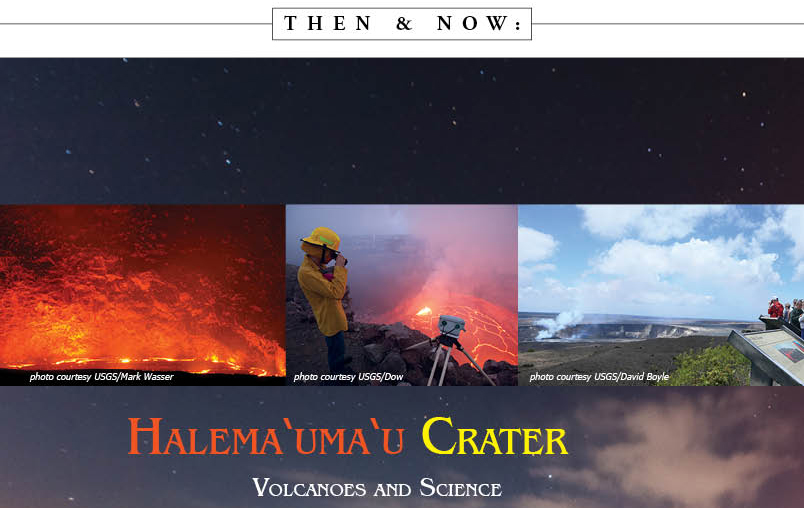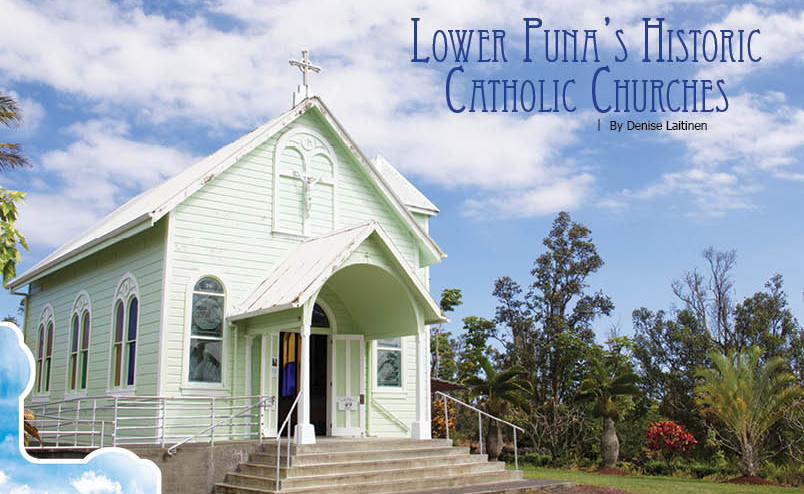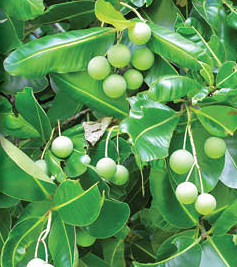
Halema‘uma‘u Crater: Volcanoes and Science

By Alan D. McNarie
Hawai‘i Island’s tourist industry got a big boost last spring when Madame Pele chose to peep out of the windows of her home. Lava rose for a few weeks in the pit of Halema‘uma‘u Crater, at the summit of Kīlauea, such that we could actually see it from the summit overlook at Jaggar Museum. This was the closest that visitors have been allowed to approach the crater since an active summit eruption began there in 2008. The “red stuff” overflowed from the pit-within-a-pit where it had been hiding and surged across the crater floor, while at the same time low fountains spouted from between drifting plates of newborn black stone. It was, as volcanologist Matt Patrick noted, “A great opportunity for the public to safely see the lake,” the first such a time in this century.
Although the lava has since subsided and visitors can currently see only an indirect glow, the summit eruption continues and may flare up again. Meanwhile, Matt and his fellow scientists at the US Geological Survey’s Hawaiian Volcano Observatory continue to monitor the pit’s still-bubbling lava lake through cameras in custom-built plastic cases (“If you buy an off-the-shelf camera enclosure, it’s usually made out of metal, which doesn’t work well on a volcano,” he observes; “The sulfuric acid from the eruption quickly eats holes in them.”) The scientists also monitor an array of hypersensitive electronic instruments, many of which were either invented or first adapted for volcanological use on Hawai‘i Volcano Observatory.
While this spring’s phenomenon was unusual for the 21st Century, it had been the norm for extensive periods of the past. For most or all of the 19th Century and the first 24 years of the 20th Century, lava bubbled continuously from the floor of Kīlauea Caldera. That long volcanic event shaped our modern view of volcanoes worldwide: it was the first eruption in human history to be continuously scientifically studied. Halema‘uma‘u, the traditional home of the Hawaiian volcano goddess Pele, became the birthplace of the modern study of Volcanology.
“If that [lava] lake hadn’t been here, we wouldn’t be here today,” notes Don Swanson, another volcanologist at the USGS’s Jaggar Volcano Observatory, headquartered next to the museum.
The earliest roots, however, of what became the Hawaiian Volcano Observatory might be traced to another volcano, coincidentally named Mont Pelee (“Pelee” in French, means “bald”) far away on the island of Martinique in the West Indies. In 1902, a pyroclastic (hot ash and gas) flow from Pelee had buried the city of St. Pierre and killed an estimated 30,000 people. The event left only three known survivors: a prisoner who survived because his stone jail cell was too poorly ventilated to admit the hot ash, a shoemaker on the edge of the flow who suffered severe burns, and a young girl who managed to paddle out to sea.
A Massachusetts Institute of Technology geologist named Thomas A. Jaggar, Jr. participated in an expedition to record the aftermath of the Martinique catastrophe. Jaggar was “appalled by what he saw, and dedicated his life to learning about volcanoes in order to preserve life,” says Don.
Jaggar later came to Hawai‘i Island and gave a lecture that included an account of his Martinique experiences. Inspired by his talk, some local residents formed Hawaiian Volcano Research Association (HVRA), with a Latin motto that translated roughly as “Let no more cities be destroyed.”
“Before the 20th Century, most studies of volcanoes were conducted during short-lived expeditions,” such as the one to Martinique, notes a USGS publication called Eruptions of Hawaiian Volcanoes—Past Present and Future, which Don co-authored. Thomas Jaggar “…was not satisfied with that approach. He recognized that, to understand volcanoes fully, one must study them continuously before, during and after eruptions.”
“In 1912, with support from the HVRA and the Whitney Fund of MIT, Jaggar established the Hawaiian Volcano Observatory (HVO) to study the activity of Mauna Loa and Kīlauea on a permanent, scientific basis,” recounts Eruptions of Hawaiian Volcanoes. “‘Volcanology’ emerged as a modern science with the founding of HVO.” It was a risky career move for Jaggar; he was abandoning his tenured professorship at MIT to head up this new undertaking. Volcanology has always involved a certain amount of risk-taking in the name of improving public safety.
Of course, what made Hawai‘i ideal for Jaggar’s purposes was the summit eruption in Halema‘uma‘u. This had been going on since at least 1823, when the missionary William Ellis became the first person of European ancestry to reach the volcano’s summit. Ellis had noted “an immense gulf” dotted with several lava lakes and 51 cinder cones.
In the 189 years between Ellis’ journey and Jaggar’s arrival, many other visitors had left their own accounts of the eruption. Among the most famous were Isabella Bird and Samuel Clemens (Mark Twain), who arrived in 1866, shortly after the original Volcano House Hotel, a literal grass shack, had been expanded into what he called a “Neat, roomy, well furnished and well kept hotel.”
“The surprise of finding a good hotel at such an outlandish spot startled me, considerably more than the volcano did.” Writing as a correspondent for the Sacramento Union, Twain described two separate lakes of lava bubbling on the floor of the caldera: “The greater part of the vast floor of the desert under us was as black as ink, and apparently smooth and level; but over a mile square of it was ringed and streaked and striped with a thousand branching streams of liquid and gorgeously brilliant fire! It looked like a colossal railroad map of the State of Massachusetts done in chain lightning on a midnight sky,” he wrote. “Through the glasses, the little fountains scattered about looked very beautiful. They boiled, and coughed, and spluttered, and discharged sprays of stringy red fire—of about the consistency of mush, for instance—from ten to fifteen feet into the air, along with a shower of brilliant white sparks—a quaint and unnatural mingling of gouts of blood and snowflakes!”
Isabella Bird, one of the most intrepid world travelers of the century, records her 1873 visit to Hawai‘i in a book entitled Six Months in the Sandwich Islands. Like Mark Twain, she found two lava lakes. Where Mark Twains’s are dotted with words like “beauty” and “gorgeous” Bird’s account sounds hellish and harrowing, full of phrases such as “lurid, gory, molten, raging, sulphurous, tormented masses of matter.” And in her explorations, she took risks that would make a modern park ranger blanch. On one visit to the crater, for instance, she and her companion, an amateur geologist named Green, left their reluctant guide behind and repeatedly jumped over a smoking fissure to reach a shelf over one of the lakes. “Mr. Green, in his scientific zeal, crossed the crack, telling me not to follow him, but presently in his absorption with what he saw, called me to come, and I jumped across, and this remained our perilous standpoint,” she wrote. “Burned, singed, stifled, blinded, only able to stand on one foot at a time, jumping back across the fissure every two or three minutes to escape an unendurable whiff of heat and sulphurous stench, or when splitting sounds below threatened the corruption of the ledge: lured as often back by the fascination of the horrors below; so we spent three hours.”
At the time of their visits, Don notes, “There was no regulation at all,” of the visitor industry. “The national park hadn’t been founded. When Volcano House was founded, they trumpeted visits to the lava lake, because that was how they got business.”
Sometime after Isabella Bird’s visit, the northern lava lake disappeared. The southern one probably became what is now known as Halema‘uma‘u. It was still steaming away when Thomas and his team arrived to stay.
While the visitors before Thomas Jaggar were not usually scientists, and while their descriptions were colored with their own personalities, their published accounts and their entries in Volcano House’s guest books contain, as Don notes, a lot of “good information” that has benefitted the scientists who followed. They’ve gotten still more from earlier historic accounts and Hawaiian traditions; they know, for instance, that in 1790, an explosive eruption wiped out the army of a Ka‘ū chieftain named Keōua, paving the way for his rival Kamehameha’s becoming Hawai‘i’s first king.
Additionally, the scientists have gleaned even more information from the ground itself. Ash and lava layers, lava bombs and pele’s hair—fine strands of volcanic glass—all provide geologic evidence of various eruptions at various times. Charcoal from burned forests can be Carbon-14 dated, giving scientists the approximate times when lava set them afire. The further back in time, the vaguer the picture becomes—“We can’t do a very good job beyond 2,500–3,000 years ago,” Don notes. The evidence has painted a broad picture of the volcano’s activities over the centuries. And in the long term that picture can be a little alarming.
“The past is the key to the future, I think,” says Don. “Eventually, what’s going to happen is that the lava lake will disappear, the floor of the caldera will collapse again, and we’ll enter into an extended period of explosive activity. Periods like we’re in now can last for centuries…this is the kind of activity that builds the volcano.” He says, “The geologic work that we do shows that these periods will end.”
When the current period does end, the volcano may behave more like it did in 1790—or in 1924. That’s the year when that previous long summit eruption ended. Don believes it was also the first year in modern times when somebody actually died in Kīlauea Caldera.
As of 1924, the observatory had been in existence for a dozen years. The volcanologists’ instruments, crude though some were, allowed them for the first time to track changes all over the mountain and connect the dots: first, the lava lake at Halemau‘ma‘u began draining; then on April 21, 1924, at the land far downhill in Kapoho, on the Puna Coast, the volcano’s crust began to swell, accompanied by swarms of earthquakes. This allowed the scientists to guess where the missing lava had gone. Then, as the level of lava in the summit crater fell below the water table, the scary part began: a series of increasingly powerful steam explosions hurled huge boulders as if they were toys. According to the Hawaiian Volcano Obsevatory’s journal, however, scientists and a few adventurous visitors, including such VIPs as Lorin A.Thurston, continued to visit the caldera between explosions even though they couldn’t predict when the next explosion would occur. One such event caught several people out in the crater—including a Pāhala resident named Truman Taylor, when his legs were crushed by a boulder and who subsequently died in Hilo. He became Kīlauea’s first modern-era fatality.
Scientists thus learned one of nature’s ironies: a volcano can actually be at its most dangerous when its lava levels drop. That’s when steam explosions such as the one that killed Taylor and pyroclastic flows such as the one that eradicated St. Pierre can occur. And according to Don, the best data that the scientists have amassed show that while Hawai‘i has gone through long periods when Kīlauea was full of lava, it has also gone through long periods when lava levels were a dangerous fraction of what they are now. During such a period, he notes, “Pyroclastic surges could reach into Volcano Village…. You don’t need to expect that a surge will happen within a week or two—that would be very unlikely. But eventually, it will become likely.”
The good news is that, thanks to the information they have amassed, scientists can better predict when those dangerous times are about to arrive. Don even has a rough trigger number: to start a new explosive period, he says, lava would have to drop “about 450 meters” from its current level.
The new lava lake in Halema‘ma‘u is helping the volcanologists refine that knowledge even further. For the first time in modern history, Matt observes, a flank eruption and summit eruption are occurring simultaneously, allowing volcanologists to correlate the rises and falls of the summit lava lake. They now know that the lava arrives there first, with later eruptive activity downslope at Pu‘u ‘Ō‘ō. They’re able to map and predict the volcano’s behavior with increasing detail.
Also, the new summit eruption is being measured with a whole new generation of exquisitely fine-tuned instruments: everything from new GPS and satellite radar systems, to electronic tiltmeters so sensitive that they have to be “de-tuned” so they won’t pick up shifts of the earth caused by the moon’s gravity. Matt and his fellow volcanologists are watching every rise and fall of the lava lake not only with optical cameras, but also with near-infrared cameras that can peer through smoke and mists. It’s all a far cry from the crude early tiltmeters that HVO scientists pioneered, measuring the differing levels in water containers linked with hoses in order to detect deformations of the volcano’s crust (and hence the movement of lava beneath it).
All of which brings the volcanologists just a little closer to that goal set forth by the that group of Hawai‘i Island citizens more than a century ago, when they backed a maverick geologist’s dream of a volcano observatory.
Although cities may yet be destroyed by volcanoes, with all the new technology we can be hopeful fewer people will die in them. ❖
Contact Hawai‘i Volcanoes National Park: 808.985.6000
Contact the writer


